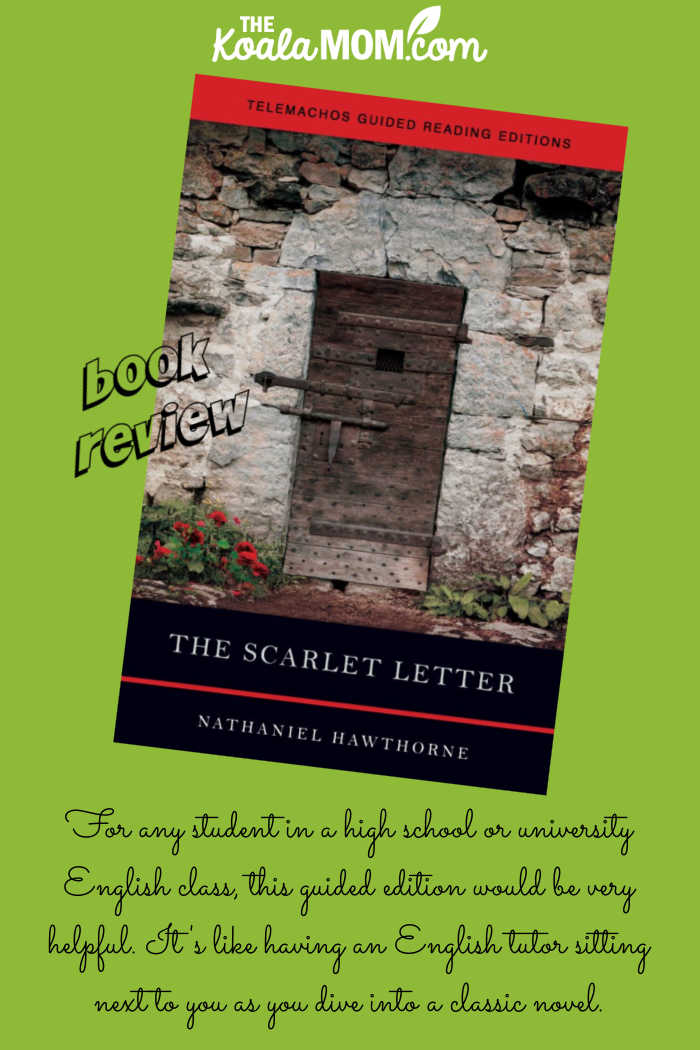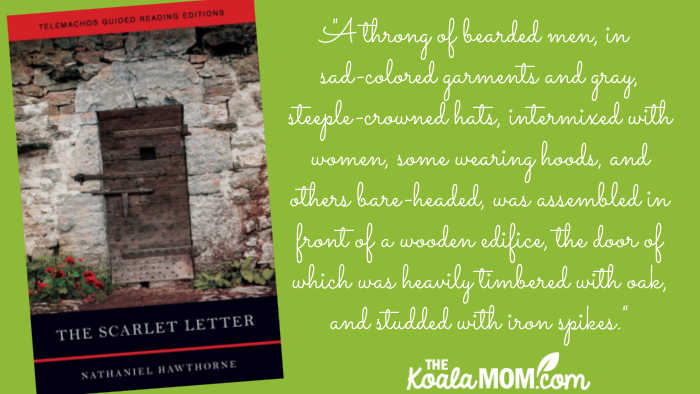The classics of English literature are novels that have stood the test of time in being relevant and interesting to each new generation of readers. Unfortunately, while the stories themselves still ring true, sometimes the words or manner of telling the stories change over time, so that older novels become less accessible to younger readers. High school students trying to tackle books written in the last century often struggle to understand the story in the midst of long descriptions, unfamiliar words, and the author’s own opinion coming forth on the pages. That’s where the Telemachos Guided Reading editions can help.
The Telemachos Guided Reading editions provide invaluable resources to help enhance a modern student’s understanding and enjoyment of the story. I recently had the chance to review the Telemachos Guided Reading edition of The Scarlet Letter by Nathaniel Hawthorne.

I received this book for review courtesy of the author; all opinions expressed remain my own. This post contains affiliate links; as an Amazon associate, I earn from qualifying purchases.
The Scarlet Letter overview
The Scarlet Letter was written by American author Nathaniel Hawthorne in 1850. The story itself is set two hundred years earlier, in a Puritan colony in Massachusetts in the 1640s. It was vastly popular when it was first published, and was one of the first mass-produced books in the US. It’s often considered a great American novel, assigned to English students to read, and has been adapted numerous times for film, TV, and stage. Despite this, it’s a difficult read for 21st century readers.
I remember reading The Scarlet Letter in high school. It was probably a novel that my mom handed to me (a voracious reader) because it was a classic and thus I should read it. All I remember from reading it was that there was a woman who’d committed adultery and was forced to wear a red A on her dress for the rest of her life. I did remember that it was rather tough to get through as a teenager, and I wondered how differently I’d find it as an adult.
I wasn’t surprised to find the first half of the novel rather slow. Hawthorne would have been severely remanded in any of my writing classes for “telling, not showing.” He writes long-winded summary and descriptive paragraphs about Hester, her village, and how she is treated… but very little action or dialogue actually happens within the story. He gives several paragraphs of overview about how Hester’s neighbors turn their backs on her, but I would have rather seen an actual scene showing what a few specific neighbors did.
The novel begins with Hester coming out of the jail with her infant and being sentenced to stand before the villagers, then wear the red A to show her sin. We see her raising her daughter at the edge of the village while helping those in need around her despite how she is shunned by the villagers. Hester’s former husband takes up residence with Mr. Dimmesdale, the town rector, and has nothing to do with her. Mr. Dimmesdale’s holiness and admiration among the villagers is contrasted to Hester’s sin and disparagement. Other minor characters include the governor, an old woman thought to be a witch, and the “crowds” in various scenes.
The second half of the novel was a much faster read. Hester and Pearl were real, likeable characters and I really wanted to find out how she managed to end this life of condemnation. Hawthorne reveals who Pearl’s father is; he and Hester are briefly reunited and make a plan for a new life. However, that plan is thwarted by Hester’s former husband, who has waited and plotted his revenge for many years. The climactic ending may disappoint modern readers, who want a “happily ever after” for Hester and her lover, but it fits with Hawthorne’s moralistic themes.
My thoughts on this classic
Pearl brings as much cheer and fun to the story as she does to her mother’s life; she is an imp of a child who does what she wants and isn’t constrained to the strict, Puritan laws around her. She is also one with nature, a solitary girl who is able to entertain herself on the beach or in the forest. Hawthorne’s descriptions of her are beautiful, showing the resilience of a child raised with a loving parent, with freedom to explore her world and be herself.
Hawthorne does have a somewhat dry sense of humor and poked fun occasionally at the Puritans: “Into this festal season of the year… the Puritans compressed whatever mirth and public joy they deemed allowable to human infirmity; thereby so far dispelling the customary cloud, that, for the space of a single holiday, they appeared scarcely more grave than most other communities at a period of general affliction.”
Does Hawthorne’s story about Puritan colonists deserve its reputation as a classic? Yes. I’d honestly love to read a modern version of this novel, that develops Hawthorne’s characters more deeply and delves further into their thoughts and actions. However, each of the main characters does feel very real, raw, and honest, while the villagers (the antagonists, in many ways) remain shadows. This sets up one of Hawthorne’s themes: us vs. them. And that’s a theme that I think many modern readers would do well to reflect on.
The villagers judge Hester and others in the novel by appearances. Hester is forever the woman who committed adultery, no matter how many poor people in the village she helps. Others are held up as heroes, despite what we know about their inner lives thanks to our narrator. How often do we, in our modern world, continue to judge those around us by what we see of their lives, when we know nothing about what they are living with? And while we no longer have the legalistic religious rules that constrained the Puritans, we often impose other rules on each other.
Telemachos Guided Reading editions
On most pages of this guided reading edition is a small box with questions pointing to particular details or information in the story. These questions helped me pay attention to certain things as I read. They were rather like street signs, warning about what was coming up. There were also footnotes on many pages, explaining obscure words and vague historical references. At the end of the novel is a glossary for quick reference.
For any student in a high school or university English class, this guided edition would be very helpful. It’s like having an English tutor sitting next to you as you dive into a classic novel. I could see how the questions highlighed themes, ideas and details that a student would need to write an essay or discuss The Scarlet Letter in class.
For example, Hawthorne’s descriptions are not merely because writers were more wordy in the 18oos; he uses physical descriptions throughout the novel to highlight other facts about his characters. The changes in the physical appearance of the main characters throughout the novel shows their emotional and psychological changes as well, and the guided edition helps readers pay attention to these details.
The guided edition also begins with a section on writing essays, showing examples for students. This makes this edition like a textbook-in-a-novel. Homeschooling teens could use this as an English course, reading the novel and using the prompts and essay examples at the beginning to write their own notes and essays on the novel. High school and university students would find the examples a helpful addition to their teacher’s or professor’s lectures and notes.

Moms, you may get more out of this novel than your teens! I’m honestly not sure why this is chosen for high school studies, as it doesn’t seem like a good pick to me. Teens will have a hard time identifying with Hester and her peers, but as moms, there’s so much to learn from her. The questions on each page would be great discussion prompts for a mom’s book club.
Currently, there are Telemachos Guided Reading editions available for A Tale of Two Cities, The Great Gatsby, A Christmas Carol, and The Scarlet Letter.
More about the Editor
Michael Degen, the guide and publisher of the Telemachos Guided Reading editions, is a seasoned AP English teacher and college board consultant with over three decades of experience. He seeks to provide a unique guided reading experience, enhancing interpretive skills and deepening understanding of literary classics. He is also the author of other books for English teachers and students, including The English Coach’s Instructional Playbook and Crafting Expository Argument: Practical Approaches to the Writing Process for Students and Teachers. To learn more about his books and teaching tips, drop by his website.

No Responses Yet